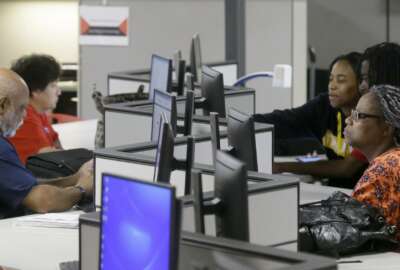Best listening experience is on Chrome, Firefox or Safari. Subscribe to Federal Drive’s daily audio interviews on Apple Podcasts or PodcastOne.
In the year since the Trump administration first described its intention to modernize the federal workforce, agency officials have largely been talking about those plans in relatively broad strokes.
It wants to reskill federal employees to take on more high-value work. It wants to shorten the federal hiring process. It wants to improve employee engagement and performance. And it wants to reorganize some agencies to more efficiently manage and refocus federal human capital.
But specific actions that the administration wants to take — whether through legislation or administrative action — to accomplish these goals are still mostly unclear. The Office of Personnel Management took a major step earlier this month in announcing new direct-hire authorities, but other action-plans for the federal workforce are still hazy.
Yet the MITRE Corporation this week compiled a series of recommendations and ideas that hint, in some cases, exactly how government could make good on the Trump administration’s plans.
The recommendations come from discussions the Office of Management and Budget held last month at its first-ever Symposium on the Federal Workforce of the 21st Century. It’s the first time these ideas and themes have been made public, as media wasn’t invited to cover the symposium.
Many of MITRE’s broad recommendations may sound familiar at this point, as several overlap with the suggestions other organizations have offered in recent months.
“Anything that you do should consider the employee experience,”said Jim Cook, vice president of strategic engagement and partnerships at MITRE. “The organizations don’t work effectively if our people aren’t engaged and our people aren’t productive and our people aren’t fulfilled.”
For example, the ever-changing nature of work in the 21st century demands that government find ways to modernize and update the federal workforce to meet and exceed those expectations, the report said.
MITRE again made the case that agencies should find ways to use critical hiring authorities more often. Government, in general, needs to develop stronger partnerships with leading private sector organizations to share talent, the report said.
And pay and rewards should be more closely tied to employee performance and production, Cook said.
“Instead of ranking and rating people against each other, [you should] look at what individuals bring to organization, the skills, the results and the behaviors that they bring,” he said. “That represents the value to the organization, both now and into the future. Compensation in many organizations now is being aligned to address the value component, not just the performance component.”
Government has barriers to overcome first
But MITRE’s report perhaps definitely details more specific steps the administration could take in both the short-term and long-term to resolve workforce challenges. In addition, it also described specific barriers that government faces in implementing these recommendations and what could be done administratively or legislatively to reverse course.
These specific examples came from points that the symposium’s attendees made in the room, but they also came from experiences that MITRE has had working with government. Cook said it was important that the report get as detailed as possible in mentioning potential roadblocks.
“If OMB is going to move out and work with others to implement any of these ideas, we should know what we need to solve for in order to make it happen,” he said.
The Intergovernmental Personnel Act program, for example, has its limitations in allowing agencies to facilitate talent exchanges, because it’s designed to avoid personal and organizational conflicts of interest. Agencies can also use the experts and consultants authority in Title 5 to bring in private sector expertise on a temporary basis, but similar legal and ethical restrictions make the authority difficult to use, Mitre said.
As March 2018, 2,841 employees are on expert and consultant appointments in government, according to OPM data cited in Mitre’s report.
Government should reexamine these challenges embedded within existing government ethics regulations, Mitre suggested.
“These arrangements carry risks in terms of the potential for losing talent and intellectual property,” the report reads. “This is one reason some organizations are cautious about these relationships. The government should develop strategies to mitigate these risks.”
When recommending an expansion of critical hiring authorities, for example, MITRE pointed to a current cap on critical position pay. Government can only use this authority, the report said, for 800 positions at one time.
Labor-relations partnerships
Notably, the MITRE report also recommends government find ways to collaborate with labor organizations, a point that some federal unions might argue has been largely absent from their most recent dealings with the administration today.
But MITRE said participants at the symposium were optimistic about the opportunity agencies had to collaborate with federal labor organizations, particularly with the administration’s push to reskill some federal employees.
“Managers want to obtain hard-to-fill knowledge, skills and abilities, and labor wants to provide developmental opportunities that result in higher salaries or continued employment,” the report reads.
At least one former federal union leader attended OMB’s symposium, Cook said. Attendees heard about one instance where labor and managers at the Naval Sea Systems Command’s Portsmouth Naval Shipyard in Maine worked together to improve employee performance and engagement.
“We thought that needed to be reinforced, and we think that there’s opportunities to do that beyond just one particular instance like Portsmouth, but why not be able to do that governmentwide?” Cook said.
In addition, MITRE also recommended OMB continue to host a federal workforce symposium at least once a year. Smaller groups could convene throughout the year to focus on specific topics. Other organizations with similar ideas and best practices could compare notes.
“There’s a degree of convergence, and when there’s that level of convergence then anything’s possible,” Cook said.
Copyright
© 2024 Federal News Network. All rights reserved. This website is not intended for users located within the European Economic Area.

